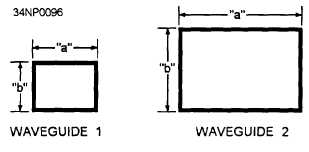As shown in figure 3-23, the widest dimension
of a waveguide is called the “a” dimension and
determines the range of operating frequencies. The
narrowest dimension determines the power-handling
capability of the waveguide and is called the “b”
dimension.
Figure 3-23.—Labeling waveguide dimensions,
NOTE: This method of labeling waveguides is
not standard in all texts, Different methods may be
used in other texts on microwave principles, but this
method is in accordance with Navy Military Standards
(MIL-STDS).
In theory, a waveguide could function at an infinite
number of frequencies higher than the designed
frequency; however, in practice, an upper frequency
limit is caused by modes of operation, which will be
discussed later.
If the frequency of a signal is decreased so much
that two quarter-wavelengths are longer than the wide
dimension of a waveguide, energy will no longer pass
through the waveguide. This is the lower frequency
limit, or CUTOFF FREQUENCY of a given
waveguide.
In practical applications, the wide
dimension of a waveguide is usually 0.7 wavelength
at the operating frequency. This allows the waveguide
to handle a small range of frequencies both above and
below the operating frequency. The “b” dimension
is governed by the breakdown potential of the
dielectric, which is usually air. Dimensions ranging
from 0.2 to 0.5 wavelength are common for the “b”
sides of a waveguide.
ENERGY PROPAGATION IN
WAVEGUIDES
Since energy is transferred through waveguides
by electromagnetic fields, you need a basic understand-
ing of field theory. Both electric (E FIELD) and
magnetic fields (H FIELD) are present in waveguides,
and the interaction of these fields causes energy to
travel through the waveguide. This action is best
understood by first looking at the properties of the
two individual fields.
E Field
An electric field exists when a difference of
potential causes a stress in the dielectric between two
points. The simplest electric field is one that forms
between the plates of a capacitor when one plate is
made positive compared to the other, as shown in view
A of figure 3-24. The stress created in the dielectric
is an electric field.
Electric fields are represented by arrows that point
from the positive toward the negative potential. The
number of arrows shows the relative strength of the
field. In view B, for example, evenly spaced arrows
indicate the field is evenly distributed. For ease of
explanation, the electric field is abbreviated E field,
and the lines of stress are called E lines.
H Field
The magnetic field in a waveguide is made up of
magnetic lines of force that are caused by current flow
through the conductive material of the waveguide.
Magnetic lines of force, called H lines, are continuous
closed loops, as shown in figure 3-25. All of the H
lines associated with current are collectively called
a magnetic field or H field. The strength of the H
field, indicated by the number of H lines in a given
area, varies directly with the amount of current.
Although H lines encircle a single, straight wire,
they behave differently when the wire is formed into
a coil, as shown in figure 3-26. In a coil the individual
H lines tend to form around each turn of wire. Since
3-12


